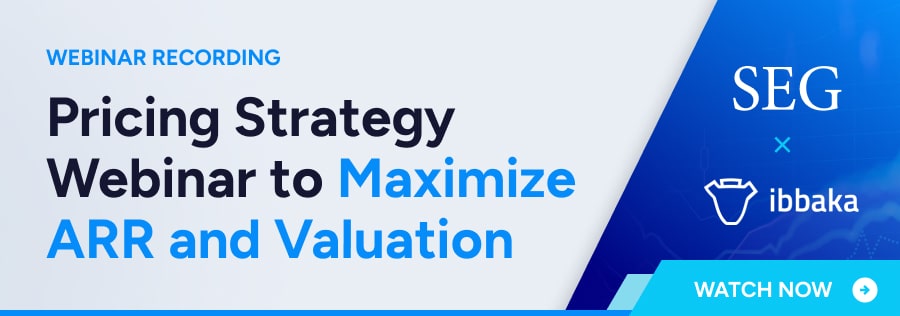How to Optimize Your Company’s LTV to CAC Ratio

Running a thriving software business requires, among other things, two foundational capabilities. First, you must find ways to acquire new customers without overspending on sales and marketing. Second, you need those customers to stick around and provide recurring revenue to your company, ideally for years. If you can succeed in these two areas, your SaaS business stands a great chance of growing and attracting the interest of investors and buyers.
To get a clear view of how well you’re meeting this dual goal, it helps to be familiar with a metric called the LTV:CAC ratio. In long form, it stands for Customer Lifetime Value (LTV) to Customer Acquisition Cost (CAC), and its purpose is to measure the efficiency of your customer acquisition strategy. Put another way, the LTV:CAC ratio shows how much value you extract from each customer compared to how much it costs to acquire them.

As discussed in our white paper, “20 Factors to Track When Valuing Your Software Business,” the revenue a customer brings in should, ideally, exceed the cost to acquire them. A high LTV:CAC ratio means the business is seeing a good return on its sales and marketing investments. This translates to increased profitability and, in turn, enhances your company’s value in the eyes of investors. Conversely, a low ratio suggests you may be spending too much on customer acquisition compared to the revenue it generates.
We wrote an earlier blog post that discusses exactly how to calculate LTV:CAC and what constitutes a “good” ratio (6x or higher is generally considered strong). But what if your company isn’t doing that well? In this article, we will focus on how your business can improve its performance on both sides of the coin; that is, how to acquire more customers while spending less, and how to get the most revenue from every customer relationship. We’ll provide some actionable strategies to help you unlock your SaaS company’s growth potential and increase your valuation for future exit opportunities.
Reducing Customer Acquisition Costs
Let’s start on the sales and marketing side, examining how your company keeps new customers coming. Customer Acquisition Cost (CAC) represents the average cost of acquiring a new customer. To improve your LTV:CAC ratio, it’s important to focus on winning new business efficiently to keep acquisition costs low. Here are three key areas to emphasize:

- Optimize Marketing Spend. It’s marketing 101 – don’t waste time and money to gain the attention of people who have no interest in your product. Rather, ensure your marketing campaigns target a well-defined audience of high-potential customers. To reduce your reliance on paid advertising, consider a content marketing program (articles, guides, videos, etc.) combined with SEO techniques to bring traffic to your site organically. You might also try offering referral incentives to existing happy customers who can help you acquire new ones. And be sure to explore today’s modern automation tools that can help you streamline marketing tasks and enhance your campaigns.
- Improve Sales Efficiency. Good salespeople are incredibly valuable, not only in winning customers but in building a foundation for long-term relationships. So, hiring experienced salespeople and investing in additional sales training can pay dividends in the long run. Make sure your sales team is equipped with the knowledge, tools, and technology they need to build a database of high-quality leads, deliver a compelling proposition and close deals faster. Read our dedicated post on driving sales efficiency to learn more.
- Leverage Partnerships and Affiliates. No business in the modern world exists in a vacuum; we are all part of a larger ecosystem of interconnected organizations. Smart companies take advantage of this fact by collaborating with others in their professional community. For your SaaS business, this could mean forming strategic marketing partnerships with complementary companies or creating affiliate programs to compensate outsiders who promote your product.
Ultimately, the more your company can “work smarter, not harder” to win new customers, the less it will cost, and your LTV:CAC ratio will climb.
Enhancing Customers’ Lifetime Value
On the other side of the coin is Lifetime Value (LTV), which is the total revenue a single customer generates over the entire duration of their relationship with your company. By employing strategies to win higher-value customers, keep them satisfied and increase their spending over time, you will improve your LTV:CAC ratio. Here are four specific areas to address:

- Focus on Customer Segmentation and ICP. Segmenting customers will allow you to better tailor your marketing campaigns toward the prospects most likely to purchase. In that way, it not only cuts down on selling expenses, but it also helps you identify your highest value customers and thus allocate the proper resources to ensure they are satisfied and successful. You can evaluate and segment your customer base by industry, product, size, or any other applicable data.

Along with customer segmenting, take time to develop your Ideal Customer Profile (ICP). This should be a detailed description of a hypothetical “perfect customer,” a company that would benefit most from your product and generate the highest lifetime value. By focusing your efforts on acquiring and retaining ICP customers, you can maximize ROI and ensure long-term growth.
This kind of research and analysis can prove incredibly fruitful. Just consider the story of Andrea Pitts, SVP of Global Sales for Arena Solutions. In this webinar, Andrea explains how her company narrowed its focus from 40 segments down to 12, and growth skyrocketed as a result.

- Improve Customer Retention. It’s not enough to win high-value customers; you also must hold onto them. If your company has a problem with customer churn, you may need to upgrade your customer support operation to be more responsive and adept at resolving issues. You may also consider launching proactive customer success programs, aimed at building relationships and helping customers get the most from your product. Customer loyalty programs that incentivize repeat business can also be effective, as can more frequent communications to keep your company front-of-mind with customers.
- Increase Upselling and Cross-Selling. Beyond winning customers and keeping them happy with the status quo, you can increase their LTV by earning more of their business over time. Consider offering packages or bundles that combine multiple products or services, increasing the average order size. You might also explore tiered pricing models, which encourage upgrades by offering more features at higher price points. Furthermore, leverage customer data to make personalized recommendations that complement the customer’s current product.
- Enhance Product Value. Carefully consider customer feedback and make regular updates to ensure your product addresses their needs while being easy and enjoyable to use. Introduce new features and functionalities that add value and enhance the customer experience. Be sure to monitor competing products to make sure yours stays up to par or better. By consistently focusing on improving your product, you’ll not only keep existing customers happy, but it may open the door to potential price increases in the future.
To recap, the keys to increasing LTV are finding the customers who need your product most and exceeding their expectations so they will gladly continue to subscribe and upgrade their services over time.
Building a Data-Driven Strategy
While any of the ideas above could help improve your company’s LTV to CAC, software entrepreneurs know that smart business decisions aren’t based on hunches or anecdotal evidence. Thanks to modern technology that makes it relatively easy to collect and analyze hard data, there is no reason to make assumptions. Using data to better understand your operations and your customers, you can arrive at a tailor-made plan to drive more revenue and control costs. Here are three suggestions:

- Monitor and Analyze Key Metrics. You need to know if the strategies and programs you have in place are actually working. Tracking metrics like customer churn, sales pipeline velocity, and marketing campaign performance can help you decide whether to stick with your current approach or try something different.
- Take Customer Feedback Seriously. Instead of waiting for them to contact you, actively solicit customer feedback through surveys, interviews, and support interactions. Then systematically analyze responses to better understand customers’ needs and concerns. The occasional complaint may be anomalous, but data from across your customer base may reveal a recurring issue that needs to be corrected.
- Conduct A/B Testing. Not sure which marketing message or pricing model is going to resonate better with your target audience? Try them both! Utilize software to continuously test different versions of the same content or product, collecting data on which one elicits more clicks, registrations, or purchases. Doing so allows you to finetune your approach to different market segments and ultimately drive more sales.
Reaping the Rewards
Implementing tried-and-true business strategies based on objective data, your company will be well on its way to optimizing its LTV:CAC ratio. And that spells success in multiple ways:
- It increases profitability by generating more revenue from customers than it costs to acquire them.
- It serves as evidence to buyers and investors that you have a sustainable business model with predictable revenue streams.
- It reduces business risk by retaining high-value customers and reducing the need for constant customer acquisition.
- And it fuels future growth, freeing up resources for further product development, marketing expansion, or strategic acquisitions.

Optimizing LTV:CAC isn’t something you can achieve overnight, nor is the work ever really finished. It’s an ongoing process and an ever-present goal. But it’s absolutely worth the effort to make your SaaS business as healthy, competitive and resilient as it can be. And when it comes time to consider selling the company, a strong LTV:CAC is likely to pay off in spades.
Our Strategy to an Optimal Valuation
The above strategies can go a long way in improving your company’s LTV to CAC ratio. With an improved ratio, your company will be on its way to reaching a higher valuation.
Please contact us if you wish to discuss the best method for optimizing the LTV to CAC ratio for your business. We offer a complimentary Strategic Assessment where we take a look at your company to discover M&A opportunities.











